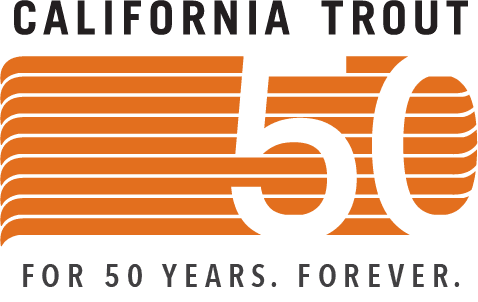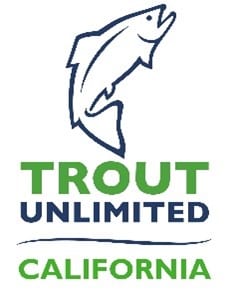Trout Clout: CalTrout and TU Joint Statement on New CA Inland Trout Regulations
Dear fellow advocates for California’s trout and salmon,
On March 1st, 2021 the California Department of Fish and Wildlife (CDFW) implemented new Inland Trout Sportfishing regulations that will change the angling season(s) and experience on many waters. CDFW will also, as directed by the California Fish and Wildlife Commission, changed the general statewide fishing regulations on March 1.
The final regulation packet can be found here. Regulations for your favorite trout streams may have changed so please review this packet before your next visit to the river.
As many of you are aware, Trout Unlimited California and California Trout have followed the state’s regulatory change process closely, and engaged in multiple ways with CDFW and the Commission to make sure that our wild trout populations are conserved and that our best special regulations waters retain their unique character and fishing experience.
Since the initial proposal for simplifying the Inland Trout Regulations was released in early 2019, TU and CalTrout worked collaboratively to deliver our members’ values and priorities to both CDFW staff and to the Fish and Wildlife Commission, throughout the public comment period. Our principal goals were:
- to protect and enhance populations and habitat of native and wild trout;
- to support the Department’s goals with respect to establishment and management of designated Wild Trout waters;
- to support the Department’s goals with respect to the R3 program (which aims to recruit and retain more purchasers of California fishing and hunting licenses, in part through improving angling opportunities statewide);
- to honor long-established angling traditions and practices for specific waters, where these are consistent with broader resource management goals;
- To improve access for angling where appropriate or critically needed.
Some of our priorities are reflected in the new regulations. In particular, the new general statewide regulations now require catch-and-release only, no-bait practices for the winter and early spring, in all streams. Such measures are appropriate during that season, when most trout species are vulnerable as they congregate and spawn. Previously, the statewide regulations allowed a 5 fish take, 10 fish bag limit year-round with no gear restrictions.
However, the final simplified regulations do not go far enough to protect our wild trout waters, especially given the impacts on coldwater fisheries of the hotter and drier conditions we are projected to experience in California. We must manage our trout resources more flexibly, with better monitoring of wild and native trout population trends, if we want future generations of anglers to have the same opportunities we do today.
Moreover, the State’s focus on “simplifying” freshwater angling regulations limited their willingness to keep some of the special regulations that have helped define the fishing experience on many iconic streams. CDFW and the Commission should re-visit and revise the new regulations for the following to better conserve native and wild trout populations or to enable better access throughout the year (there are likely other waters that also merit adjustments to their regulations).
Upper Sacramento River: Rather than three different regulations for different stream segments for this famous, wild trout-dominated water, we recommend a unified regulation: year-round, 2 fish bag, barbless artificial lures only. This would maintain harvest opportunities while adequately protecting large spawning fish that migrate up from Shasta Lake. Such a regulation would better meet the primary management objective of the 2000 Fishery Management Plan for the Upper Sacramento River (“to develop a world-class wild trout fishery”).
East Walker River: This trophy wild trout water, by long tradition primarily a catch and release fishery, has had a year-round season—until now. The new regulations close the “EW” from November 15th through the last Saturday in April, and allow increased harvest (from 1 trout to 2 trout) for the full open season. For this iconic water we support catch-and-release angling year-round with barbless artificial lures.
Mokelumne River: The new, simplified regulations allow for harvest of wild trout on “The Moke.” Our proposal is for catch-and-release angling year-round with artificial, barbless lures from the Highway 49 Bridge downstream to Lake Pardee at Middle Bar Bridge. That would make The Moke the sole catch-and-release only stream in the Sierra foothills, while maintaining harvest off Middle Bar Bridge (provides angling opportunities for persons with disabilities).
East Fork Carson River: The new regulations allow harvest of wild trout in this river downstream of Hangman Bridge (traditionally catch-and-release only water). We support a return to catch-and-release regulations with artificial lures and barbless hooks from Hangman Bridge to the Nevada state line. This management approach would best meet two primary goals under the 1979 East Fork Carson River Wild Trout Management Plan.
Fall River Complex (includes Ahjumawi, Eastman Lake, Lava Springs, and Bear Creek): This famous fishery, one of California’s few true spring creeks, now allows harvest and use of bait. We support a year-round angling season here with single barbless, artificial lures only and zero take.
Lastly, the new, simplified Inland Trout Regulations continue the State’s over-reliance on hatchery production and stocking to provide trout fishing opportunity in many waters. This model is outdated, costly, and inconsistent with other resource management and conservation goals and policies.
TU and CalTrout will continue to work with CDFW and the Fish and Wildlife Commission to monitor the performance of the new simplified regulations and to revisit and revise them as needed to protect native and wild trout and the angling experience on certain waters. We will hold CDFW accountable to do post-regulation change monitoring and creel surveys, provide support for monitoring through our staffs and memberships, and keep an open dialogue with CDFW staff. We will also lead efforts to submit petitions for changes to the new regulations, as needed or appropriate.
We appreciate your continued support for our advocacy on behalf of California’s native and wild trout, and to preserve the unique character and angling experience of certain streams. For more information, or to convey a concern, please contact TU’s Sam Sedillo (ssedillo@tu.org) or CalTrout’s Patrick Samuel (psamuel@caltrout.org).








1 Comment
I’m wondering if you guys support catch and release only on the Truckee River. I have been fishing the Truckee for about 40 years and release nearly all of my fish. But sometimes take one home and I enjoy doing that.